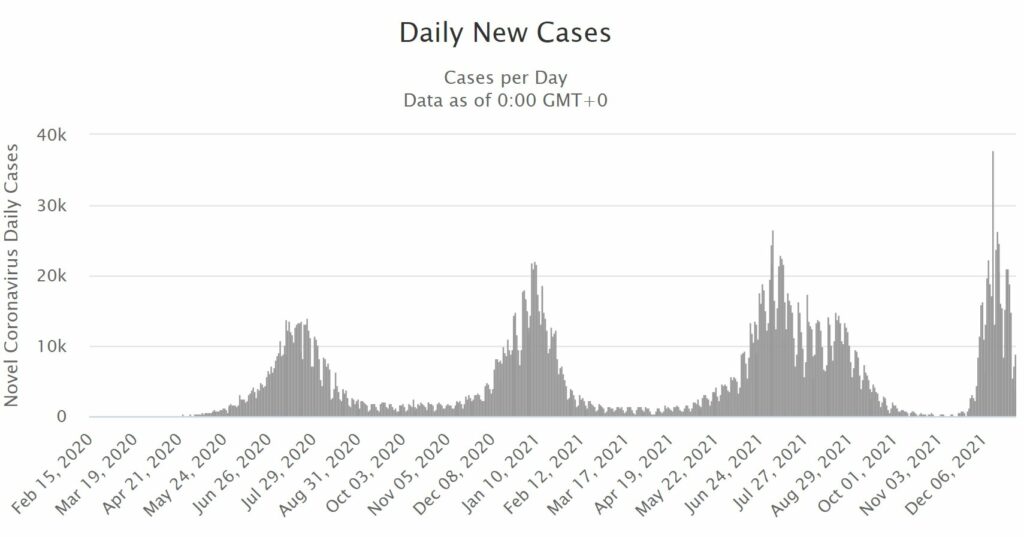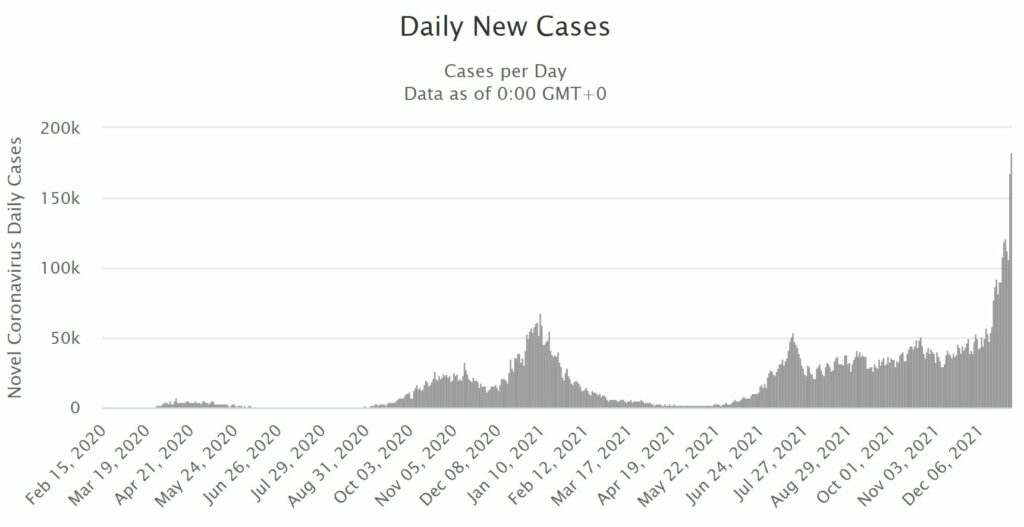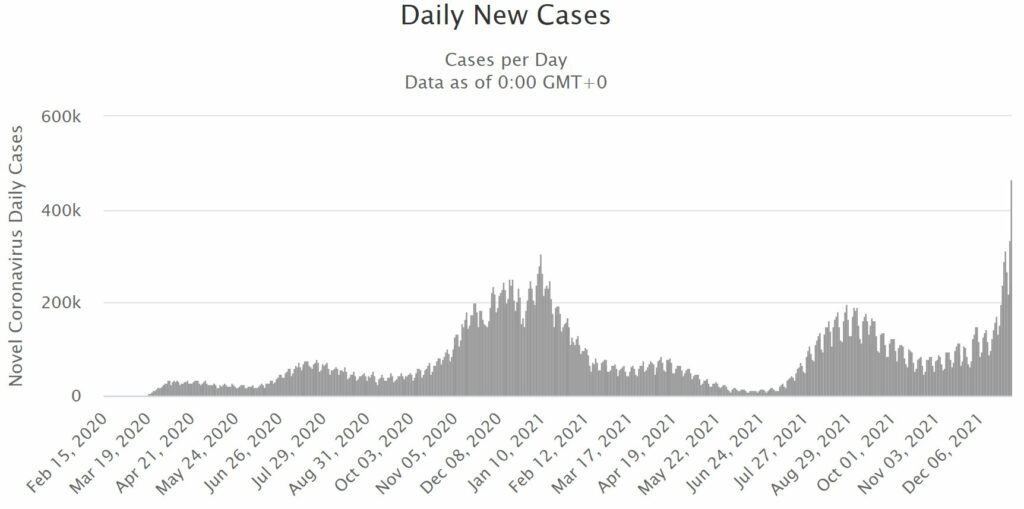So much has changed from my “part 1” post on November 30 and “part 2” post on December 15. The world is facing some harsh realities as Omicron spreads rapidly around the world, with cases doubling every two days in countries where the latest variant has taken root. According to Worldometers, the U.K. had 189,000 reported cases on Thursday while the U.S. had 572,000 cases. In the U.S., with the scarcity of test availability right now and the large number of asymptomatic cases, it isn’t a stretch to think that the actual numbers are more than 1 million new infections a day, or that daily positive tests could surpass 1 million after New Year weekend.
What do we know?
- Clearly, with a two-day doubling rate, Omicron spreads easily and efficiently.
- Omicron does evade the vaccines, as we have seen positive tests in the unvaccinated, vaccinated, and vaccinated/boosted populations.
- The overwhelming majority of new cases in the vaccinated/boosted population are mild symptoms with very small numbers requiring medical treatment outside the home.
- Whether it was due to global vaccine strategy, vaccine hoarding, or limits on vaccine production, the disproportionate rollout of vaccines across wealthier vs. poorer nations couldn’t prevent this variant. As of today, 50% of the world is fully vaccinated against COVID-19 (two doses), while 59% has received at least one dose. Based on data from the New York Times, in the U.S. and Canada, those numbers are 64%/74%. Latin America 60%/71%. Asia/Pacific 58%/69%. Europe 60%/65%. Middle East 50%/60%. Meanwhile, Africa sits at only 9% fully vaccinated and 13% receiving at least one dose.
What do we believe?
- Scientists believe that Omicron will result in fewer hospitalization and deaths on a per case basis than previous variants. The words “on a per case basis” are critically important. With the potential the U.S. may have more than 1 million reported cases per day (and possibly an equal number of unreported cases) within the next week, the absolute number of hospitalizations and deaths may still reach record highs. Medical systems will strain under the pressure, especially since doctors and nurses will test positive due to Omicron and will be forced to the sidelines for days.
- Other in-person sectors of our economy will be similarly impacted. The transportation sector has already been hit hard with airlines and public transportation already feeling the pressure of positive tests among the workforce. Education will be hit hard once winter break ends in public schools next week and universities at different points in January. Many schools are switching to remote learning when classes resume.
What do we hope?
- The rapid spread of Omicron may cause it to burn itself out faster than previous variants. South Africa’s earliest cases were back-dated to the second week in November. By middle of December, their new cases already began to decline. Now, South Africa has dropped below 10,000 daily cases with a population fairly comparable to the United Kingdom. With other variants, the duration of the curve from trough to peak was 2 to 2.5 months. With the U.K. ahead of the U.S. by around 10 days, we need to be watching their curve to see if it starts to bend at around 1.5 months which would be mid-January. If it does, then perhaps the U.S. curve will begin to bend by late January.
The South Africa Curve

The United Kingdom Curve

The United States Curve

- It is possible that the Omicron variant may overwhelm the more medically severe Delta variant, causing Delta to burnout. That would be a modest silver lining.
- It is possible that so many people become infected with the Omicron variant – unvaxxed, vaxxed, boosted – that we do get to some level of collective immunity, making it harder for new variants to gain hold.
The six risk factors for international travel
Omicron has changed the pandemic paradigm: We can no longer hide from COVID-19. While some countries added controversial travel restrictions for Southern African nations in late November, these are already being lifted. There seems to be little appetite among governments for another global travel shutdown. The inevitability that Omicron will impact all countries at some point has led a majority of governments to keep their flights operating and tourism sectors open. This is very different from 2020 and early 2021. For travelers, this is good news because there is less of a chance that their travel plans will need to be cancelled due to government actions.
For individual travelers, continue to assess these six risk factors before making a “go” or “no go” decision about a trip.
1) How likely are you to get very sick if you get COVID-19? The answer for most healthy adults who have been boosted is “unlikely”. I am not recommending international travel for vaccinated/unboosted clients who are more than six months beyond their initial vaccine sequence.
2) How is the general quality of medical care in your country of travel, and how strained are the hospitals if you do get sick? Even countries with excellent health care systems may find themselves stretched to capacity during their Omicron spike.
3) How likely are you to have your trip cancelled before departure if you test positive for COVID-19? This risk is now the highest it has been, so make sure you have purchased trip cancellation insurance with a full range of coverages.
4) How likely are you to test positive for COVID-19 before returning home, forcing you to quarantine and delay your return? This risk is now also the highest it has been, but also depends on when Omicron takes hold in your country of travel. If you absolutely need to return and can’t afford to get stuck, you may need to defer travel.
5) How likely is it that governmental rule changes force you to cancel your trip? This now seems less likely for most countries, based on how governments have reacted (or not reacted) over the past two weeks when the rate of Omicron spread became clear. Check out this website from Airheart which provides an overview of country-by-country restrictions: https://airheart.com/travel-bans/from/united-states It defaults to travel from the U.S. but this can be easily changed.
6) How likely is Omicron to impact the quality of your travel experience once you arrive? If you are planning a beach vacation, or an outdoor active vacation, or an international visit with family, your travel plans may not be heavily impacted by COVID-19. But if you were planning to spend a lot of time indoors visiting museums and cultural events, you may find closures or other limitations that severely impact the quality of your trip.
For group travelers, I am very concerned about January and now February departures. With 30 people in a group, the odds of a positive test greatly increase and it is likely that there would be more than one positive traveler. An entire group could be delayed in country, and the impact of this would become a logistical nightmare for group coordinators. Frequently, groups have an essential need to return home after travel and can’t afford the risk of being quarantined overseas, so this is an additional consideration. Finally, while changing return airline tickets for 2-4 people is usually manageable, trying to change return flights for 30 people can be a massive challenge.
Feel free to reach out if you need help assessing the risk factors or if you have questions about traveling during the pandemic.






